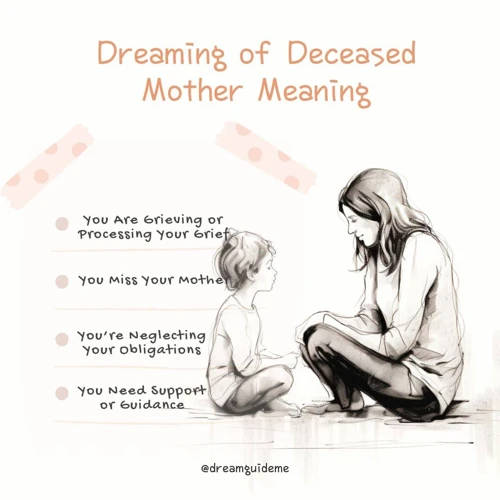Exploring the Meaning of Visits from Deceased Loved Ones in Spiritual Dreams: Have you ever experienced a dream where you felt the presence of a departed loved one? These mystical encounters, known as spiritual dreams, hold a profound significance to many individuals. In this article, we delve into the fascinating realm of spiritual dreams, seeking to understand their true nature and the messages they may convey. From analyzing symbols and signs to sharing real-life experiences, we explore the emotional healing, closure, and deeper connections that these dreams may offer. Join us on this journey as we combine scientific analysis with spiritual perspectives to unravel the enigmatic world of dreams and the encounters with those who have passed beyond the veil.
Understanding Spiritual Dreams

1. Explaining spiritual dreams: Spiritual dreams are vivid, profound, and often carry a profound sense of connection and meaning. These dreams go beyond the realm of ordinary dreams, as they involve encounters with departed loved ones or spiritual beings. In these dreams, the veil between the physical and spiritual worlds seems to thin, allowing for unique experiences and messages to be conveyed. Some believe that spiritual dreams serve as a way for departed loved ones to communicate with us, while others see them as a means for spiritual growth and guidance. To explore the depths of these dreams further, you may want to engage in lucid dreaming techniques to enhance your awareness and recollection of these profound experiences.
2. Recognizing the power of dreams: Dreams have fascinated and intrigued humanity for centuries. They hold a significant place in various cultures and spiritual traditions around the world. Dreams are believed to be a doorway to the subconscious mind, providing insights, revelations, and guidance. Spiritual dreams, in particular, carry immense power and potential for personal growth and transformation. These dreams can offer solace, reassurance, and even answers to unresolved questions. Engaging in practices such as spiritual dream meditation can help you tap into the deep well of dreams and explore their hidden meanings.
1. Explaining spiritual dreams
- Nature of spiritual dreams: Spiritual dreams are characterized by their vividness, intensity, and profound emotional impact. These dreams often feel more real than ordinary dreams, as if one is truly interacting with a spiritual realm. They can occur spontaneously or be invoked through practices like meditation or visualization.
- Connection with departed loved ones: One prevalent aspect of spiritual dreams is encounters with departed loved ones. These dreams may provide an opportunity for individuals to feel the presence of their loved ones who have crossed over to the other side. These encounters can bring comfort, closure, and a sense of continued connection even after the physical departure.
- Messages and guidance: Spiritual dreams can also serve as a means of receiving guidance or messages from the spiritual realm. Symbolism and metaphor are typical ways in which these messages are conveyed. It is important to pay attention to the symbols and details within the dream as they may hold significant meaning or guidance for the dreamer.
- Growth and transformation: Exploring and understanding spiritual dreams can lead to personal growth and transformation. These dreams can offer insights into one’s own psyche, unresolved emotions, or unresolved relationships. By delving into the depths of these dreams, individuals may gain a deeper understanding of themselves and their connection to the spiritual world.
- Interpretation and analysis: It is crucial to approach the interpretation of spiritual dreams with an open mind and heart. While there are common symbols and archetypes that appear in dreams, personal context and experiences play a significant role in understanding the specific meaning of each dream. Consulting resources on symbolic animal dreams or working with a dream analyst or spiritual guide can assist in deciphering the messages embedded in spiritual dreams.
2. Recognizing the power of dreams
2. Recognizing the power of dreams:
- Self-reflection and personal growth: Dreams offer a unique opportunity for self-reflection and personal growth. By examining the symbols, emotions, and narratives within our dreams, we can gain valuable insights into our subconscious mind. These insights can help us understand our fears, desires, and unresolved issues, empowering us to make positive changes in our waking life.
- Creative inspiration and problem-solving: Dreams have long been a source of inspiration for artists, writers, and innovators. The imagery and narratives that unfold in our dreams can spark our creativity and provide fresh perspectives on creative projects or problem-solving. Many individuals have attributed breakthrough ideas or solutions to problems to their dreams.
- Emotional processing and healing: Dreams can serve as a powerful tool for emotional processing and healing. They provide a safe space to explore and express deeply buried emotions and traumas. Dreams can act as a form of catharsis, helping us release emotional baggage and find emotional healing and closure.
- Intuitive guidance and spiritual connection: Dreams have been recognized as a channel for intuitive guidance and spiritual connection. They can serve as a bridge between our conscious mind and the wisdom of our higher self or the spiritual realm. Paying attention to the messages and symbolism in our dreams can unlock profound spiritual insights and guidance.
By recognizing the power of dreams and their potential for personal growth, creative inspiration, emotional healing, and spiritual connection, we can begin to embrace and honor the significance of these nighttime journeys.
Visits from Deceased Loved Ones

1. Significance and meaning of encounters:
When a departed loved one visits us in a spiritual dream, it is a powerful and profound experience. These encounters hold deep meaning and significance. It is believed that the presence of our loved ones in our dreams is a way for them to communicate with us from beyond the physical world. These visits often occur during times of emotional need or important life events, offering comfort, guidance, and reassurance. The significance of these encounters lies in the connection and love that transcends death, allowing for continued support and healing.
2. Messages from beyond the veil:
Visits from deceased loved ones in spiritual dreams often come with messages. These messages can take various forms, such as words spoken, symbolic images, or even feelings transmitted. These messages can provide answers to unresolved issues, guidance for navigating challenges, or simply a message of love and support. It is important to pay attention to the details and symbols within the dream as they can hold the key to understanding the message being conveyed. Keep an open mind and heart to receive the messages from beyond the veil.
3. Emotional healing and closure:
One of the most significant aspects of visits from deceased loved ones in spiritual dreams is the potential for emotional healing and closure. These dreams offer an opportunity to reconnect with our departed loved ones, allowing for unresolved emotions and unfinished business to be addressed. The presence of our loved ones in these dreams can bring a sense of peace, forgiveness, and acceptance. It allows for a final goodbye or an opportunity to express things left unsaid. Spiritual dreams can support the process of grief and provide a sense of closure, ultimately helping us on our journey of healing.
1. Significance and meaning of encounters
1. Significance and meaning of encounters: Encountering a deceased loved one in a spiritual dream is a powerful and profound experience that holds deep significance. These encounters can provide a sense of comfort, reassurance, and even validation of the continued bond between the physical and spiritual realms. The presence of our departed loved ones in dreams can signify their ongoing presence in our lives and that they are still watching over us. Each encounter may hold unique meaning, whether it’s a message of love, guidance, forgiveness, or closure. It is essential to approach these encounters with an open mind and heart, allowing the messages and emotions to unfold naturally.
2. Messages from beyond the veil
In spiritual dreams, messages from beyond the veil can be conveyed through various means. These messages may come in the form of symbolic images, words, emotions, or sensations. Each individual may experience these messages differently, depending on their own personal understanding and relationship with the departed loved one. Here are some aspects to consider when interpreting the messages from spiritual dreams:
- Symbols and signs: Pay attention to the symbols and signs that appear in the dream. These symbols may hold personal significance and carry messages specific to your relationship with the departed loved one. It is important to approach the interpretation of symbols with an open mind and intuitive awareness.
- Emotions and sensations: Take note of the emotions and sensations you experience during the dream. Sometimes, the messages are not conveyed through explicit symbols but rather through a deep sense of love, peace, or reassurance. Trust your intuition and the feelings that arise within you during and after the dream.
- Words and communication: Direct communication through spoken words or messages may also occur in spiritual dreams. These messages may provide guidance, comfort, or answers to questions you may have. Be attentive to any words or phrases that stand out in the dream, as they may hold significant meaning.
- Overall energy and atmosphere: The overall energy and atmosphere of the dream can also hold messages in themselves. Pay attention to the colors, sounds, and overall vibe you experience. These elements may offer insights into the intentions and purpose of the dream visitation.
Remember that interpreting messages from beyond the veil is a deeply personal and individual process. Trust your intuition and allow the messages to unfold naturally, as their true meaning may become clearer with time and reflection.
3. Emotional healing and closure
Emotional healing and closure: One of the profound aspects of visits from deceased loved ones in spiritual dreams is the potential for emotional healing and closure. These dreams often provide individuals with an opportunity to connect with their departed loved ones, creating a sense of comfort and peace. The presence of a loved one in a dream can evoke intense emotions, allowing for the release of grief, guilt, or unresolved emotions. By providing a platform for communication and connection, spiritual dreams can facilitate the healing process and bring about a sense of closure. It is not uncommon for individuals to wake up from these dreams feeling a profound sense of relief and emotional release. The memories and experiences shared in these dreams can act as a source of solace and help individuals come to terms with the loss of their loved ones.
Interpreting Symbols and Signs

1. Common symbols in spiritual dreams: Spiritual dreams often contain symbolism that carries personal and universal meanings. These symbols can vary from person to person, but there are some common symbols that frequently appear in these dreams. Some examples include white doves, which symbolize peace and divine intervention, butterflies representing transformation and rebirth, or water symbolizing emotional healing and purification. Understanding these symbols can offer deeper insight into the messages and lessons conveyed in spiritual dreams.
2. Analyzing personal connections: In addition to universal symbols, spiritual dreams may also include personal symbols that hold significance for the dreamer. These symbols can be specific objects, places, or even people that have a deep emotional connection. For example, a deceased loved one appearing in a dream may hold immense personal meaning and serve as a profound message or source of comfort. Paying attention to these personal connections and delving into the emotions they evoke can assist in deciphering the messages and intentions behind spiritual dreams.
1. Common symbols in spiritual dreams
Common symbols in spiritual dreams: Spiritual dreams often utilize symbols as a means of communication. These symbols can hold deep personal significance or have broader, universal meanings. Here are some common symbols that may appear in spiritual dreams:
- White light or bright light: A symbol of divine presence, spiritual awakening, and enlightenment.
- Feathers: Representing messages from angels or loved ones, feathers can symbolize guidance and protection.
- Water: The element of water in dreams often represents emotions, purification, and healing.
- Butterflies: A powerful symbol of transformation, freedom, and rebirth.
- Doors or gateways: Representing new opportunities, spiritual growth, and transition.
- Mirrors: Reflecting self-reflection, introspection, and gaining insights into one’s true self.
- Animals: Different animals hold different symbolic meanings. For example, a bird could signify freedom or a connection to the spiritual realm, while a lion may represent strength and courage.
- Numbers: Numbers in dreams can carry significant meaning, such as the number 3 representing completeness or the number 7 symbolizing spiritual insight and intuition.
- Books: Often seen as a symbol of knowledge, wisdom, and spiritual guidance.
It’s essential to remember that the interpretation of symbols will vary from person to person and may have personal associations unique to your own experiences. Trust your intuition and explore the meanings that resonate with you.
2. Analyzing personal connections
2. Analyzing personal connections: When exploring the symbols and signs within spiritual dreams, it is essential to consider the personal connections and associations they hold. Each individual has their unique set of experiences, memories, and relationships, which shape the symbolism in their dreams. By reflecting on these personal connections, you can begin to unravel the deeper meanings hidden within the dream’s imagery. For example, if you dream of a specific location that holds sentimental value to you and your deceased loved one, it could signify a message or a reminder of the bond you shared in that place. Additionally, pay attention to the emotions and sensations experienced during the dream, as they can provide valuable insights into the messages being conveyed. By carefully analyzing these personal connections, you can navigate the intricate tapestry of your spiritual dreams and gain a deeper understanding of the messages from beyond the veil.
Experiences Shared by Others

1. Real-life stories of spiritual dreams: Countless individuals have shared their experiences of spiritual dreams, recounting the profound encounters they have had with deceased loved ones. These stories often involve vivid imagery, intense emotions, and a deep sense of connection. Some have reported seeing their loved ones in a peaceful and radiant state, while others have described conversations and messages conveyed in these dreams. These personal tales serve as a testament to the power and significance of these encounters, offering comfort and hope to those who have also experienced similar dreams.
2. Lessons learned from these encounters: The experiences shared by others in their spiritual dreams often highlight the transformative impact these encounters can have on individuals. Many have found solace and closure through these dreams, gaining a sense of peace and healing from the connection they felt with their departed loved ones. These dreams can also provide valuable insights and guidance, leading individuals to make positive changes in their lives or pursue their passions with renewed determination. By listening to and reflecting on these stories, we can learn from the wisdom and profound experiences of others in navigating our own spiritual dream journeys.
1. Real-life stories of spiritual dreams
1. Real-life stories of spiritual dreams: The realm of spiritual dreams is rich with captivating and transformative experiences shared by individuals from various walks of life. One such story involves Sarah, who lost her father at a young age. Years later, she dreamt of her father, who conveyed a sense of love and comfort, reassuring her that he was at peace. This dream brought Sarah a deep sense of healing and closure, allowing her to move forward with her life.
Another remarkable story involves Michael, who had been estranged from his sister for many years before her passing. In a spiritual dream, Michael and his sister were reunited, and she expressed forgiveness and love towards him. This dream provided Michael with a profound sense of closure and the opportunity to mend their relationship, even after her passing.
These real-life accounts highlight the powerful and transformative nature of spiritual dreams. They offer glimpses into the realm where departed loved ones can communicate, offer guidance, and provide emotional healing. These experiences serve as a testament to the significance and impact that spiritual dreams can have on individuals’ lives.
2. Lessons learned from these encounters
2. Lessons learned from these encounters:
- Understanding the eternal nature of the soul: One of the most profound lessons gained from encounters with deceased loved ones in spiritual dreams is the reassurance that life transcends physical existence. These dreams serve as a reminder that our souls continue to exist beyond death, offering comfort and hope to those who have experienced loss.
- Fostering emotional healing and closure: Spiritual dreams provide a unique platform for emotional healing and closure. They offer an opportunity to resolve any unresolved issues, express love and forgiveness, and find a sense of peace. The encounters serve as a catalyst for the grieving process, allowing individuals to come to terms with their loss and embark on a journey of healing.
- Strengthening the bond with departed loved ones: Through spiritual dreams, individuals can experience a renewed sense of connection with their departed loved ones. These encounters often leave a lasting impression and a deeper understanding that love transcends time and space. The experiences can bring comfort, solace, and a sense of guidance in navigating life’s challenges.
- Embracing spirituality and personal growth: Spiritual dreams can ignite a profound spiritual awakening within individuals. The messages and insights gained from these encounters encourage individuals to embark on a path of self-discovery, introspection, and personal growth. The dreams may inspire individuals to explore their own spiritual beliefs, practices, and connections with the divine.
- Living with a sense of purpose and gratitude: Encounters with deceased loved ones in spiritual dreams often leave individuals with a renewed sense of purpose and gratitude for life. These dreams remind us of the preciousness of each moment and encourage us to live authentically, cherishing our relationships and embracing the beauty of the present.
These lessons learned from encounters with deceased loved ones in spiritual dreams can have a profound and transformative impact on individuals, guiding them on their journey of healing, spiritual growth, and living a more meaningful life.
Scientific and Spiritual Perspectives
1. Analysis of scientific theories: From a scientific perspective, dreams are often seen as the result of subconscious processes, brain activity, and random neural firings during sleep. Researchers have explored various theories, such as the activation-synthesis theory, which suggests that dreams are the brain’s attempt to make sense of random neural activity. Other theories propose that dreams serve a function in memory consolidation or emotional processing. However, when it comes to spiritual dreams, science may have difficulty providing concrete explanations due to their subjective nature and the involvement of non-physical entities.
2. Insights from spiritual traditions: Spiritual traditions and beliefs offer a different perspective on dreams, recognizing them as a doorway to the spiritual realm. Many spiritual traditions view dreams as a means of communication with higher beings, departed loved ones, or spiritual guides. Across different cultures, dreams have been used for divination, prophecy, and receiving sacred teachings. These traditions emphasize the importance of dream interpretation and understanding the symbolic language that dreams often employ. Exploring the spiritual aspects of dreams can provide a deeper understanding of the connections between the physical and spiritual dimensions of existence.
1. Analysis of scientific theories
1. Analysis of scientific theories:
- Psychological perspective: From a psychological standpoint, dreams are seen as the mind’s way of processing emotions, memories, and experiences. In the case of spiritual dreams, psychologists suggest that they could be a manifestation of unresolved grief or a longing for connection with departed loved ones.
- Neurological research: Neuroscientists continue to explore the mechanisms behind dreaming. Some studies suggest that certain brain regions associated with memory and emotion, such as the hippocampus and amygdala, may play a role in the formation of spiritual dreams.
- Quantum consciousness: A more metaphysical approach posits that consciousness itself extends beyond the physical body. The theory of quantum consciousness suggests that our conscious experiences may be influenced by quantum phenomena, allowing for non-local connections with spiritual realms.
While scientific explanations may offer some insights into the nature of spiritual dreams, it is important to remember that dreams are highly subjective experiences, and their true meaning may be deeply personal and unique to each individual.
2. Insights from spiritual traditions
Spiritual traditions from around the world offer valuable insights into the realm of spiritual dreams. These ancient wisdom traditions recognize the sacred nature of dreams and the connection between dreams and the divine. For example, in Native American spirituality, dreams are considered a channel for communication with ancestors and spirit guides. Tibetan Buddhism places great importance on dream yoga, a practice that involves using dreams as a means for spiritual awakening and enlightenment. Hinduism believes that dreams have symbolic meanings and can provide glimpses into the past, present, and future. The Sufi tradition of Islam holds that dreams can be a direct communication from the divine. These spiritual traditions remind us of the profound significance and potential of our dreams, encouraging us to explore and honor their messages. By studying these insights, we can gain a deeper understanding of the spiritual dimensions of our dreams and their impact on our lives.
Conclusion
- Analyzing scientific theories: Scientific research on dreams and their meaning is ongoing. While some interpret dreams as simply a result of brain activity during sleep, others delve deeper into the psychological and cognitive aspects of dreams. Exploring various scientific theories can provide valuable insights into the phenomenon of spiritual dreams and their implications.
- Insights from spiritual traditions: Spiritual traditions across the globe have long recognized the significance of dreams in connecting with the spiritual realm. Whether it is the Native American belief in animal spirit guides or the ancient Hindu interpretation of dreams, these traditions offer unique perspectives on the spiritual dimensions of dreams. Exploring these insights can broaden our understanding of the visits from deceased loved ones in spiritual dreams.
In conclusion, spiritual dreams hold a special place in our lives, offering a glimpse into the realm beyond our physical existence. They provide comfort, guidance, and even closure, allowing us to connect with our departed loved ones and receive messages from the spiritual realm. By understanding the nature of spiritual dreams, interpreting their symbols and signs, and exploring the shared experiences of others, we can embark on a profound journey of self-discovery and spiritual growth.
Frequently Asked Questions
1. Can everyone have spiritual dreams?
Yes, spiritual dreams are not limited to a specific group or belief system. They can happen to anyone, regardless of their spiritual or religious background.
2. How can I differentiate a spiritual dream from a regular dream?
While regular dreams may feel fragmented and lacking in significance, spiritual dreams tend to be more vivid, emotionally charged, and often involve encounters with deceased loved ones or spiritual beings.
3. Are spiritual dreams the same as lucid dreams?
No, spiritual dreams and lucid dreams are not the same. Lucid dreams refer to dreams in which the dreamer is aware that they are dreaming and can control the dream’s narrative. Spiritual dreams, on the other hand, involve encounters with spiritual entities or hold deeper spiritual meaning.
4. How can I enhance my ability to recall spiritual dreams?
Keeping a dream journal and practicing consistent dream recall exercises can help improve your ability to remember spiritual dreams. Before going to sleep, set an intention to remember and receive messages from your dreams.
5. Are there common symbols or signs in spiritual dreams?
Yes, there are common symbols that can appear in spiritual dreams, such as white doves symbolizing peace, butterflies symbolizing transformation, or rainbows symbolizing divine blessings. However, it’s important to consider personal associations and contexts when interpreting symbols.
6. Can we initiate spiritual dreams or communicate with departed loved ones through dreams?
While it is not possible to control or force spiritual dreams, setting an intention before sleep and engaging in practices like meditation or prayer can create a conducive environment for spiritual encounters in dreams.
7. Are all visits from deceased loved ones in dreams significant?
Not all dreams involving deceased loved ones are necessarily spiritual dreams. Regular dreams may also feature departed loved ones as a result of memories or subconscious processing. Spiritual dreams often carry a distinct sense of connection, guidance, or profound impact on the dreamer.
8. Can spiritual dreams provide closure or healing?
Yes, spiritual dreams can offer emotional healing and closure by allowing the dreamer to connect with departed loved ones, receive messages of comfort or forgiveness, and find solace in the knowledge that their loved ones are at peace.
9. How can I interpret the messages received in spiritual dreams?
Interpreting the messages in spiritual dreams requires personal reflection and intuition. It is helpful to tune into your emotions, explore personal associations with the dream symbols, and seek guidance from spiritual mentors or therapists if needed.
10. Is there a scientific explanation for spiritual dreams?
While science cannot offer a definitive explanation for spiritual dreams, various theories suggest that they may stem from the brain’s processing of grief, memories, and emotions. However, spiritual perspectives see these dreams as a connection to the spiritual realm or the afterlife.








